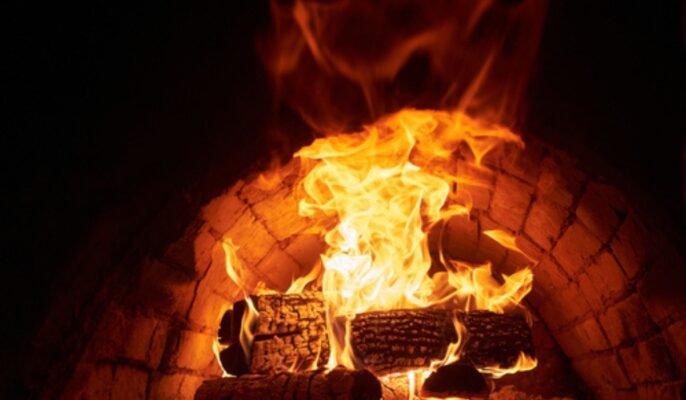A refractory brick, commonly known as fire brick, is a ceramic building material used to construct blocks that can withstand high temperatures. These bricks are made in a similar way to normal bricks except during the burning process, where they are subjected to very high temperatures.
This article describes the characteristics, properties, and types of fire bricks used in construction projects.
Source: Pinterest
See also: Types of building materials
Fire bricks: Features
Fire bricks are used to construct kilns, furnaces, and fireplaces. They have low thermal conductivity and high energy efficiency. These bricks are used where the structure is subjected to extreme mechanical, thermal, and chemical stresses. The fire bricks are not supposed to split, whatever the temperature, and their strength must be equivalent to withstand extreme temperature changes. These are bricks that can withstand temperatures of up to 1500 degrees Celsius.
Fire bricks: Clay used to make them
Fire clay is commonly found beneath coal seams and is used to make fire bricks. Fire clay has two major constituents: silica and alumina, with silica ranging from 60 to 70% and alumina ranging from 25 to 35%.
Other constituents of fireclay include oxides of potassium, magnesium, iron, potassium, and titanium. However, in the case of good fire clay, the proportion of components other than silica and alumina does not exceed 5%.
Fire bricks: Characteristics
The following are the primary characteristics of fire bricks:
- Resistance to high temperatures.
- Resistance to temperature fluctuations.
- Pressure resistance at higher temperatures.
- At higher temperatures, there is little or no expansion.
- Wear and tear resistance.
- Ability to resist reduction or oxidation.
- High abrasion resistance to dust, metal, slag, and other materials
- Low thermal absorption at high temperatures.
- Have consistency in size, shape, and composition.
- Good chemical resistance.
Fire bricks: Types
Acidic fire bricks
Acidic fire brick, also known as acid-resistant brick, is designed to withstand the acidic effects of chemicals or weather.
Regular fire brick made of natural fire clay is generally as good as an acid brick; however, if additional acid resistance is required, a different amount of silica is added to on fire clay, which can account for up to 97% of its composition. In addition, 1 to 2% of lime can be added to binding bases. Acid bricks are burned at high temperatures for extended periods.
Neutral fire bricks
The typical fire brick is made from natural fire clay mixed with sand and crushed clay. It is composed of 50-75% silica and 20-40% alumina, with a fluxing matter of less than 10%. It can be used for lining and acidic purposes. It can withstand temperatures of up to 1600°C.
Basic fire bricks
These bricks are highly resistant to corrosion and chemicals. They are high in magnesia, and lime serves as a binding agent. Magnesia-carbon bricks, magnesia-chrome bricks, and other basic fire bricks are available.
Fire bricks: Uses
- Fire bricks line the inner floors of kilns, furnaces, chimneys, and other structures to build fire-resistant structures to reduce structural defects that lead to fires.
- They are used to line the inside of a wood-fired oven.
- Due to their lower thermal conductivity, ovens are insulated with these bricks.
Source: Pinterest
Fire bricks: Advantages
- A refractory brick is explicitly used for its insulating properties. It can stop heat from passing through to the other side. Using it to build a house will keep the interior warm in the summer and winter.
- Aside from their insulating properties, fire bricks are more durable than ordinary bricks made from ordinary clay.
- Damage to regular bricks caused by changes in climate or improper storage is one of the most common issues on construction sites. Using refractory bricks requires only a dry storage area.
- A critical aspect of fire bricks is that they can be ordered from manufacturers specialising in custom fire bricks to best suit your needs.
- The price of fire bricks is reasonable. (Fire brick: Rs 12/piece, metal bricks: Rs 46/ piece)
- Fire brick is more rigid than ordinary clay-made bricks, which is why it is rated more durable than regular bricks. Despite their toughness, these bricks are incredibly light.
Fire bricks: Disadvantages
- Concrete fire brick is made of a much heavier material than other masonry components. It will increase the weight of the entire structure and raise the project’s overall cost.
- The soundproofing properties of fire bricks are poor. Because clay brick has few air holes, it cannot effectively isolate sound when it enters the building.
- Soil is the primary raw material used to make fire bricks, which is bad for the environment.
FAQs
Is there a difference between a fire brick and a kiln brick?
They are the same. Kiln bricks, also known as fire bricks or refractory bricks, are made of a ceramic refractory substance that can endure extremely high temperatures, such as those attained during kiln firings.
Is it possible to use a regular brick as a fire brick?
Regular bricks will crack in high temperatures, so only fire bricks should be used.
Housing News Desk is the news desk of leading online real estate portal, Housing.com. Housing News Desk focuses on a variety of topics such as real estate laws, taxes, current news, property trends, home loans, rentals, décor, green homes, home improvement, etc. The main objective of the news desk, is to cover the real estate sector from the perspective of providing information that is useful to the end-user.
Facebook: https://www.facebook.com/housing.com/
Twitter: https://twitter.com/Housing
Email: editor@housing.com

